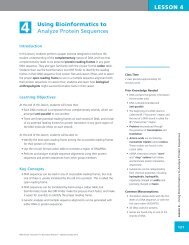WET LAB DNA Barcoding: From Samples to Sequences - Northwest ...
WET LAB DNA Barcoding: From Samples to Sequences - Northwest ...
WET LAB DNA Barcoding: From Samples to Sequences - Northwest ...
You also want an ePaper? Increase the reach of your titles
YUMPU automatically turns print PDFs into web optimized ePapers that Google loves.
<strong>WET</strong> <strong>LAB</strong><br />
CLASS SET<br />
including proteins called nucleases. Nucleases break down nucleic acids like <strong>DNA</strong>, which we don’t want <strong>to</strong><br />
happen! By adding Proteinase K <strong>to</strong> our experiment, we can prevent any nucleases from breaking down our<br />
<strong>DNA</strong> because Proteinase K will break down proteins like nucleases.<br />
7. Make sure that the lid of your microfuge tube is closed tightly, and mix the contents of your tube thoroughly by<br />
vortexing for 10 seconds.<br />
If you don’t have a vortexer, you can mix your tube by flicking it with your finger and tapping it on the table or<br />
lab bench <strong>to</strong>p, repeating every few seconds. However, if you don’t vortex your sample, you need <strong>to</strong> be sure <strong>to</strong><br />
mix it very well by hand for 1–2 minutes. The more you mix, the better your lysis will be, and the more <strong>DNA</strong><br />
you will be able <strong>to</strong> purify.<br />
8. Incubate your microfuge tube at 55°C until the tissue is completely lysed. Talk <strong>to</strong> your teacher; she or he may<br />
want you <strong>to</strong> incubate your tube overnight.<br />
Heat will help the digestion buffer dissolve the cell membrane, just like you use warm water <strong>to</strong> wash dishes.<br />
Lysis may take 1–3 hours, and is okay <strong>to</strong> leave overnight.<br />
Where is the <strong>DNA</strong>?<br />
Figure 1.1 shows a simple eukaryotic cell, with a nucleus,<br />
mi<strong>to</strong>chondria, and Golgi apparatus. For simplicity, the other<br />
organelles are not shown. Now, at the end of Day 1, you have begun<br />
<strong>to</strong> break open or lyse the cells, and the <strong>DNA</strong>, still wrapped in the<br />
nuclear membrane (the phospholipid bilayer that surrounds the<br />
nucleus) or inside the mi<strong>to</strong>chondria, is floating in the buffer in your<br />
microfuge tube. [Note: Illustrations are not <strong>to</strong> scale.]<br />
Golgi apparatus or Golgi<br />
body: A membrane-bounded<br />
cellular organelle that is involved<br />
in modifying proteins and<br />
transporting them <strong>to</strong> their final<br />
cellular destination.<br />
Using Bioinformatics: Genetic Research<br />
Figure 1.1: A Eukaryotic Cell Before Lysis<br />
(Left) and After Lysis (Right).<br />
Question 1. On a separate piece of paper or in your lab notebook, describe what happened <strong>to</strong> the cell<br />
membrane. Where did it go?<br />
350<br />
©<strong>Northwest</strong> Association for Biomedical Research—Updated Oc<strong>to</strong>ber 2012
















